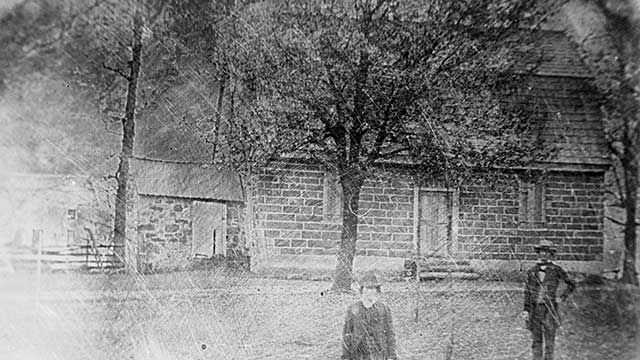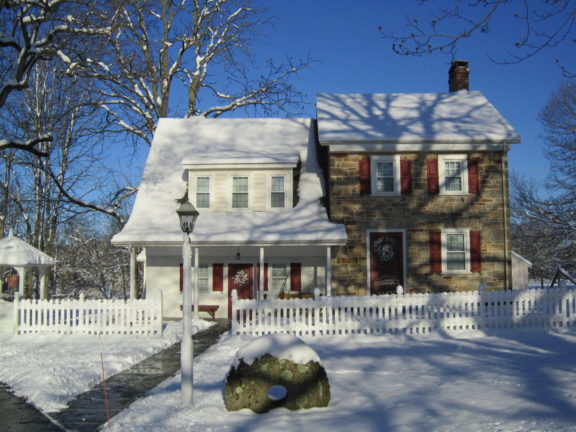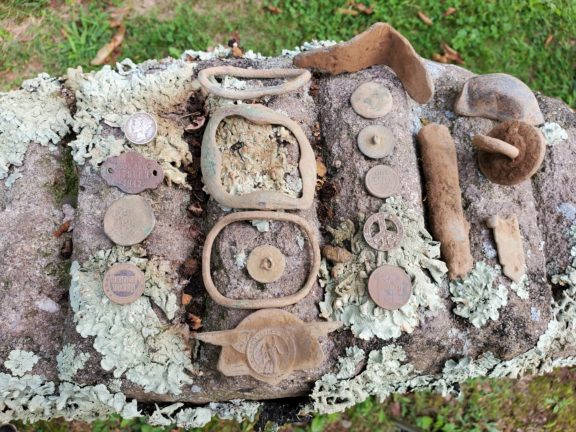
Last summer we promised to share additional stories about Quaker farms and farmers. We never quite got them underway due to the pressure of reporting on Annual Sessions, but now remedy that with thanks to Quakertown attender and farm owner, Marty Campanelli. Marty is sharing a three part series on the farm she inhabits and the Meeting she attends. A researcher of fun Quaker facts and a farmer herself (raising sheep and vegetables), Marty is also a knitter of scarves for Mercer Street Friends and a regular attender at Quakertown Meeting today.
The photo above is of a now missing daguerreotype (Hunterdon County Historical Society) that depicts the early Kingwood Meetinghouse, built by 1754 and torn down in 1862. Its stones were reused to build the present Quakertown Friends Meetinghouse that same year.
Sometime in the early 1720’s a group of Quakers migrated north from Chesterfield Meeting in Burlington County, New Jersey. They reached the hills of Hunterdon, NJ, and settled there, forming a village that would come to be called Quakertown.
Nestled on a picturesque plateau, the village was named for the religious persuasion of its residents.
The 40-mile journey back to Chesterfield Meeting would not have been an easy one on a regular basis, and the Chesterfield Meeting Minutes document that Quakertown Friends asked for permission to meet in their own homes. The minute reads: “whereas, their settlement being remote from Friends, they request Friends approbation and consent to meet together at one of their houses every First day of the week to worship God.”
Building a Meeting called Bethlehem, then Kingwood, then (finally) Quakertown
In 1733, a local Friend deeded four acres in the middle of the village for the Meeting’s use, and a structure was erected. This first house of worship was most likely built of logs.
Minutes from Burlington’s Quarterly Meeting of June, 1744 reference discussions about building a stone Meetinghouse. The stone structure was almost finished by 1752 when the roof burned, after which it took until 1754 for the new meetinghouse to be completed.
Named Bethlehem Meeting (for the then Bethlehem township), it was renamed Kingwood Meeting when Kingwood township hived from Bethleham township. Then, in 1845, the northern portion of Kingwood Township became Franklin Township and the Meeting permanently acquired the name ‘Quakertown’ for the village that it sits in.
A Farm Rises on the Edge of Town

Around 1765, at the edge of the village, a 20-acre parcel became the farmstead of a non-Quaker couple who sold the farm to a Friend named Peter Potter in 1772.
Peter set up a tanning industry along the stream that ran through the land.
After Peter married ‘out of unity’ with Quakertown Friends (choosing a bride from another faith) he sold his farm and business in 1776 to John Allen (c.1752-1828), a young man from Shrewsbury, Monmouth County.
Looking at the photo of the snow covered farm today, you can see John Allen’s original house (lower section of the left side) now whitewashed. This was the very first stone cottage (built around 1765). Later in the 1790’s John Allen built a sturdy, two-story, stone addition which stands to the right of the first house and is without whitewash. Finally a 20th century owner, Willis Vail, extended the 1765 cottage at back and added the second floor in 1923, altering the look of the left side of the house.
John’s original tan bark millstone sits by the lamppost, topped by snow.

After purchasing the house, John carried on the tanning business, crafting shoes, boots and saddles in a workshop that no longer stands on the site.
A recent metal detecting session unearthed three shoe buckles from the late 1700s near the probable location of the farmstead shop.
John attended Quaker Meeting in the village, becoming a convinced Friend. By the time that American troops–stationed a mile down the hill in Pittstown–came by to require him to sign an oath of allegiance to the Patriot cause, he refused, as did one other member of the Meeting. Both were taken to jail in Trenton.
This information is detailed in the Meeting’s Minutes from that time, which also notes both farm animals and guns that were confiscated from various other Friends to satisfy military fines.
John spent several cold and miserable weeks confined in jail, before two of his cows, a featherbed, 22 pairs of shoes, one pair of boots, and some skins of leather were seized to satisfy fines imposed by revolutionaries. (A local history book about Hunterdon County lists August 1777 as the month/year he and the other meeting member were fined.)
Thankfully they did not take John’s oxen, which were critical to turning the tan bark stone for his business.
By January of 1778, John requested membership with the Meeting, and in July he married a local Quaker woman, Mary Large (1757-1832). They soon began to raise a family…
Author: Marty Campanelli, Quakertown Meeting Attender
Next week, learn how John Allen and his descendants became an integral part of Quakertown Monthly Meeting. All photos courtesy of Marty Campanelli.